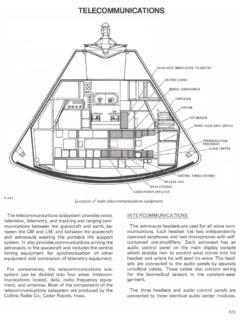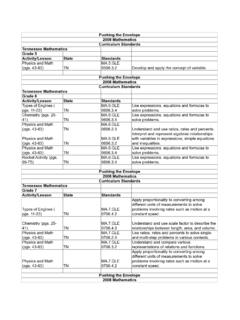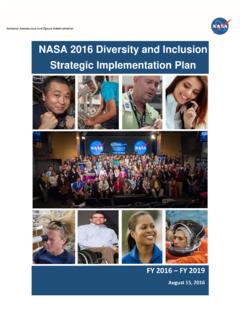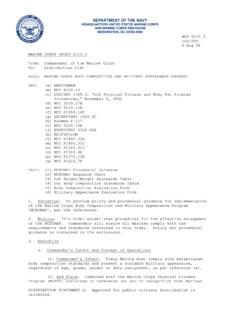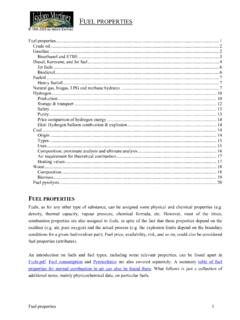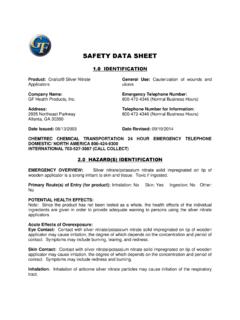Transcription of Guidebook for Proposers responding to NRAs and CANs
1 NATIONAL AERONAUTICS. AND. SPACE ADMINISTRATION. **. Guidebook FOR Proposers . responding TO A. NASA FUNDING ANNOUNCEMENT. Revised as of March 2018. TABLE OF CONTENTS. 1. Preface 2. Introduction to NASA's Programs 3. Proposal Preparation and Organization Submission Guidance Submission Requirements and Restrictions Notice of Intent (NOI) to Propose Step Approach Successor Proposals Standard Proposal Style Format Overview of Proposal Required Proposal Elements Certifications, Assurances, Representations and Sample Agreements Proposal Summary/Abstract Data Management Plan Table of Contents Scientific/Technical/Management Plan References and Citations Biographical Sketch Current and Pending Support Statements of Commitment and Letters of Resource Support Proposal Budget with Budget Narrative and Budget Details Table of Personnel and Work Effort Small Business Subcontracting Plans Special Notifications and/or Certifications Assembly of Electronic Proposals NASA Requirements for Uploaded PDF Files 4.
2 Proposal Submission NSPIRES Registration Requirements and Instructions Submitting Proposals through NSPIRES. Submitting Proposals through Other Submission Options Proposal Receipt 5. Proposal Review and Selection Administrative Review Technical and Programmatic Review Selection Based on Technical Merit Budget, Cost Analysis and Financial Withdrawal of Proposal Proposal Rejected by NASA without Review 6. Award Notification 7. Award Management 1. Appendix A Statement of General Policy Appendix B Definitions for Organization and Personnel Appendix C Costing Details Appendix D Proposal Processing, Review and Selection Appendix E Security Requirements Appendix F Multi-Year Funded Awards Appendix G Request for Reconsideration Appendix H Guide to Key Documents Appendix I Intellectual Property Appendix J Publishing Datasets on the NASA Open Data Portal 2.
3 1. PREFACE. This Guidebook describes the policies and process for submitting responses to a Broad Agency Announcement known as a National Aeronautics and Space Administration (NASA) Research Announcement (NRA) or a Cooperative Agreement Notice (CAN). The NRA is used by the program offices to request proposals for basic and applied science and technology research and for science, technology, engineering, and mathematics (STEM) education. For the purposes of this Guidebook , the NRAs and CANs are all referred to as Funding Announcements (FA). All Proposers who plan to respond to a NASA FA should adhere to the guidelines contained in this document, unless otherwise noted in the FA, including any appendices to that FA, itself. NASA funding opportunities for grants and cooperative agreements are found at: NASA. Solicitation and Proposal Integrated Review and Evaluation System (NSPIRES): and : NASA solicitations for contracts are found at the Federal Business Opportunities (FBO) site: If applying for a contract under a FA, Proposers must follow the instruction as set forth in NASA Federal Acquisition Regulation Supplement (NFS) 48 CFR Instructions for responding to NASA Research Announcements.
4 Appendix A describes the General Policies under which NASA operates, including requirement Export Control, Environmental Impact and Flight Activities. Please refer to that section to determine if any special considerations, certifications or requirements may affect the proposed activities. A NASA award, obligating the Federal funds, is signed only by a NASA Grant or Contracting Officer (also called an "Award Officer" as applicable). Unless otherwise stated Proposers should use the current Guidebook found at In case of any conflict, the order of precedence to be followed is: 1. Provisions of law;. 2. 2 CFR 1800 and the Grant and Cooperative Agreement Manual (for non-contract funding opportunities) or the NASA Federal Acquisition Regulation (FAR). Supplement (NFS) (for contract solicitations);. 3. The specific requirements noted in the FA itself; and 4.
5 The directions provided in this Guidebook . NASA does not issue awards to individuals but only to organizations, as described in Appendix B. NASA recognizes and supports the benefits of having diverse and inclusive scientific, engineering, and technology communities and fully expects that such values will be reflected in the composition of all panels and teams, including peer review panels, proposal teams, science definition teams and mission and instrumental teams. In accordance with Federal statutes and NASA policy, no eligible applicant shall be excluded from participation in, be denied the 3. benefits of, or be subjected to discrimination under any program or activity receiving financial assistance from NASA on the grounds of their race, color, creed, age, sex, national origin, or disability. NASA welcomes proposals in response to its research FAs from all qualified and eligible sources, and especially encourages proposals from Historically Black Colleges and Universities (HBCUs), Other Minority Universities (OMUs), small disadvantaged businesses (SDBs), veteran-owned small businesses, service disabled veteran-owned small businesses (SDVOSB), HUBZone small businesses, and women-owned small businesses (WOSBs), as eligibility requirements apply.
6 This Guidebook may be reproduced in part or in total without restriction. 2. INTRODUCTION TO NASA'S PROGRAMS. NASA is an independent Federal agency of the United States ( ) created by the National Aeronautics and Space Act of 1958, NASA has four Mission Directorates, each assigned responsibility for implementing NASA's Vision, Mission, and Values as outlined in the 2014. NASA Strategic Plan. The Mission Directorates are listed below: Science Human Exploration and Operations Aeronautics Research Space Technology These Mission Directorates pursue NASA's goals using a wide variety of ground-, aeronautical-, and space-based programs, and any of these may issue FAs that will incorporate this Guidebook by formal reference. NASA's Office of Education, in collaboration with the Mission Directorates and Offices, also issues FAs that solicit evidence-based projects that: 1) Foster formal and/or informal STEM education; and/or 2) Contribute to participation by underrepresented or underserved students and education organizations that predominantly (or historically) serve individuals traditionally underrepresented in STEM careers or underserved in STEM higher education including but not limited minorities, women and persons with disabilities.
7 Visit the NASA Education pages for the most up to date information about the Office of Education performance and priorities at: Complete material about all of NASA's many interests and programs is found through links starting at the NASA homepage at 3. PROPOSAL PREPARATION AND ORGANIZATION. 4. Proposers responding to a NASA FA are responsible for submitting proposals relevant to the 2014 NASA Strategic Plan or the most current Strategic Plan. Find NASA's 2014 Strategic Plan by visiting Because Strategic Plans are updated regularly and often at the same time a new budget is released, verify that the 2014 document is current by visiting If proposed activities are described or understood to be a type of education, Proposers are also responsible for submitting proposals relevant to the Federal STEM Education Five-Year Strategic Plan, a report from the Committee on STEM (Co-STEM) Education National Science and Technology Council, May 2013.
8 The requirements of this Guidebook shall be applicable unless the FA provides other instructions, such as changes to the page limits. NASA may reject without review proposals that are not consistent with the FA instructions. Submission Guidance NASA's experience in the review of proposals submitted in response to a wide variety of FAs has shown that the following directions are valuable in helping to ensure the submission of a valid, complete proposal: Carefully read the entire FA before preparing the proposals. The FA includes, but is not limited to, key dates, eligibility, program goals and objectives, funding restrictions, evaluation criteria and submission information. The FA also provides contact information, including that for the help desk(s), of persons who may answer questions regarding the FA and submission process. Follow the instructions in the specific FA as NASA is legally obligated to review and select proposals in accordance with the published FA.
9 Clearly address the objectives as listed in the FA, with an implementation plan that not only describes what is to be done but how it will be accomplished. The proposal should demonstrate a recognition of proceeding accomplishments, knowledge of key publications in the field and show how the proposed activities will extend or build on those accomplishments. If proposing innovative work in a new or emerging field the Proposers should strive to balance the provision of tutorial material and the description of new activities. Proofread the proposal carefully before submission, strive for a quality and clarity of text. When designing graphics, remember that reviewers may not be able to differentiate colors or hues therefore, choose non-color-dependent ways of conveying critical information. Propose fresh, new ideas rather than slight modifications of previously submitted proposals.
10 Simply revising a proposal to meet deficiencies identified in a previous review(s) does not necessarily guarantee a higher rating or selection of that proposal, since all proposals are reviewed on their own merit and previous scores and comments are not part of the review criteria. 5. Proposed costs must be reasonable, allowable and allocable to the proposed work. Budgets must provide all the details necessary to justify and facilitate understanding of the proposed costs. During the non-technical review process the proposer may be asked to provide additional information to justify specific items of costs. Familiarize yourself with the proposal submission process and NSPIRES website well before the deadline. If possible submit proposals well in advance of the proposal submission deadline to minimize the effect of technical difficulties that may arise.
